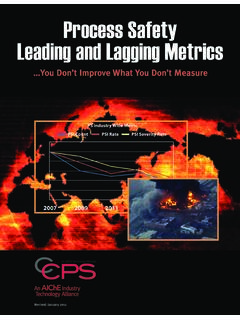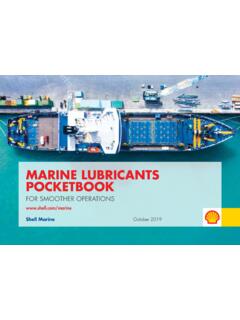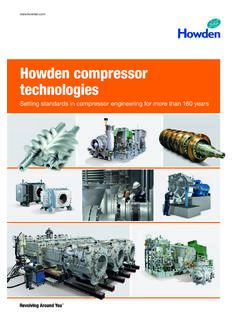Transcription of Introduction to Ammonia Production - AIChE
1 CEP September 2016 69 Back to BasicsMost people associate the pungent smell of ammo-nia (NH3) with cleaners or smelling salts. How-ever, the use of Ammonia in these two products represents only a small fraction of the total global Ammonia Production , which was around 176 million metric tons in 2014 (1). To appreciate where the industry and technology are today, let s first take a look at how we got here. Ammonia has been known for more than 200 years. Joseph Priestley, an English chemist, first isolated gaseous Ammonia in 1774. Its composition was ascertained by French chemist Claude Louis Berthollet in 1785.
2 In 1898, Adolph Frank and Nikodem Caro found that N2 could be fixed by calcium carbide to form calcium cyanamide, which could then be hydrolyzed with water to form Ammonia (2):CaO + 3C CaC2 + COCaC2 + N2 CaCN2 + CCaCN2 + 3H2O CaCO3 + 2NH3 The Production of significant quantities of Ammonia using the cyanamide process did not occur until the early 20th century. Because this process required large amounts of energy, scientists focused their efforts on reducing energy requirements. German chemist Fritz Haber performed some of the most important work in the development of the modern Ammonia industry.
3 Working with a student at the Univ. of Karlsruhe, he synthesized Ammonia in the laboratory from N2 and H2. Meanwhile, Walther Nernst, a professor of physical chemistry at the Univ. of Berlin, developed a process to make Ammonia by passing a mixture of N2 and H2 across an iron catalyst at 1,000 C and 75 barg pressure. He was able to produce larger quantities of Ammonia at this pressure than earlier experiments by Haber and others at atmospheric pressure. However, Nernst concluded that the process was not feasible because it was difficult or almost impossible (at that time) to produce large equipment capable of operat-ing at that pressure.
4 Nonetheless, both Haber and Nernst pursued the high-pressure route to produce Ammonia over a catalyst. Haber finally developed a process for producing commercial quan-tities of Ammonia , and in 1906 he was able to achieve a 6% Ammonia concentration in a reactor loaded with an osmium catalyst. This is generally recognized as the turning point in the development of a practical process for the Production of Ammonia in commercial quantities. Haber realized that the amount of Ammonia formed in a single pass through a converter was far too low to be of com-mercial interest.
5 To produce more Ammonia from the makeup gas, he proposed a recycle system, and received a patent for the concept. Haber s recycle idea changed the perception of process engineering as static in favor of a more dynamic approach. In addition to the chemical reaction equilibrium, Haber recognized that reaction rate was a determining factor. Instead of simple yield in a once-through process, he concen-trated on space-time yield in a system with recycle. BASF purchased Haber s patents and started develop- Ammonia is critical in the manufacturing of fertilizers, and is one of the largest-volume synthetic chemicals produced in the world.
6 This article explores the evolution of Ammonia Production and describes the current manufacturing PattabathulaIncitec Pivot, RichardsonCatalysts and Chemicals, LLCI ntroduction to Ammonia ProductionCopyright 2016 American Institute of Chemical Engineers ( AIChE )70 September 2016 CEPBack to Basicsment of a commercial process. After testing more than 2,500 different catalysts, Carl Bosch, Alvin Mittasch, and other BASF chemists developed a promoted iron catalyst for the Production of Ammonia in 1910. Developing equipment that could withstand the necessary high temperatures and pressure was an even more difficult task.
7 An early mild steel reactor lasted only 80 hours before failure due to decarbonization. Lining mild steel reactors with soft iron (which was not vul-nerable to decarbonization) and adding grooves between the two liners to release hydrogen that had diffused through the soft iron liner solved this problem. Other major challenges included designing a heat exchanger to bring the inlet gas to reaction temperatures and cool the exit gas, and devising a method to bring the catalyst to reaction temperature. The first commercial Ammonia plant based on the Haber-Bosch process was built by BASF at Oppau, Germany.
8 The plant went on-stream on Sept. 9, 1913, with a Production capacity of 30 Figure 1 is a flowsheet of the first commercial Ammonia plant. The reactor contained an internal heat exchanger in addition to those shown on the Production rates Ammonia Production has become one of the most important industries in the world. Without the crop yield made possible by Ammonia -based fertilizers and chemi-cals, the global population would be at least two to three billion less than it is today (3). Ammonia Production has increased steadily since 1946 (Figure 2), and it is estimated that the annual Production of Ammonia is worth more than $100 billion, with some plants producing more than 3,000 of NH3.
9 In 1983, on the occasion of the 75th anniversary of AIChE s founding, a blue ribbon panel of distinguished chemical engineers named what they believed to be the world s ten greatest chemical engineering achievements (4). Embracing such feats as wonder drugs, synthetic fibers, and atomic energy, the citation also included the breakthrough that permitted the Production of large quantities of Ammonia in compact, single-unit plants. Within the past decades, chemical engineers have suc-ceeded in creating processes that make vast amounts of Ammonia at relatively low costs.
10 As recently as 80 years ago, the total annual Production of synthesized Ammonia was just over 300,000 Thanks to chemical engineering break-throughs, one modern Ammonia plant can produce more than 750,000 Approximately 88% of Ammonia made annually is con-sumed in the manufacturing of fertilizer. Most of the remain-der goes into the Production of formaldehyde. China pro-duced about of the global Production in 2014, while Russia, India, and the produced , , and , respectively (1). While most of the global Production of Ammonia is based on steam reforming of natural gas, signifi-cant quantities are produced by coal gasification; most of the gasification plants are located in Production processes The tremendous increase in Ammonia demand from 1950 to 1980 necessitated larger, more-energy-efficient plants.













